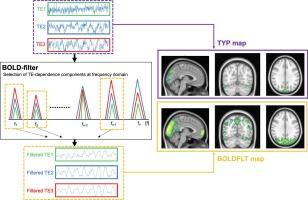Extraction of apparent BOLD components in resting state fMRI signals by a novel method called “BOLD-filter”
IF 4.9
2区 医学
Q1 ENGINEERING, BIOMEDICAL
引用次数: 0
Abstract
Resting-state functional magnetic resonance imaging (rs-fMRI) is widely used for studying brain diseases and cognition. Unlike task-based fMRI (tb-fMRI), which employs a task protocol to elicit the BOLD response, the rs-fMRI signal is itself considered a BOLD response and is used to examine brain function related to brain diseases and cognition because explicitly identifying the BOLD component in the rs-fMRI signal is challenging. In this study, we propose a novel method called “BOLD-filter” which aims to extract apparent BOLD (aBOLD) components from the rs-fMRI signal before further processing for cognitive and clinical applications. We confirm that applying the BOLD-filter to real data enables us to identify the aBOLD components in the rs-fMRI signal. Under the sufficient condition for aBOLD, among voxels of the whole brain, 84 % exhibited aBOLD signals after applying BOLD-filter, compared to only 14 % before the BOLD-filter, with the BOLD-filter identifying aBOLD signals in six times as many voxels (p = 0.001). Additionally, we observed that utilizing these apparent BOLD components enhances the association of functional connectivity with age in our example. The potential of BOLD filter to ensure BOLD response in rs-fMRI signal analysis is expected to bring a new dimension to rs-fMRI studies in relation to the understanding of brain disorders and cognitive function.

用一种名为 "BOLD-过滤器 "的新方法提取静息状态 fMRI 信号中的表观 BOLD 成分
静息态功能磁共振成像(rs-fMRI)被广泛用于研究脑部疾病和认知。与基于任务的 fMRI(tb-fMRI)不同,tb-fMRI 采用任务协议来激发 BOLD 反应,而 rs-fMRI 信号本身被认为是 BOLD 反应,用于研究与脑疾病和认知相关的脑功能,因为明确识别 rs-fMRI 信号中的 BOLD 部分具有挑战性。在本研究中,我们提出了一种名为 "BOLD-过滤器 "的新方法,旨在从 rs-fMRI 信号中提取表观 BOLD(aBOLD)成分,然后再进行进一步处理,以用于认知和临床应用。我们证实,将 BOLD 过滤器应用于真实数据,能够识别 rs-fMRI 信号中的 aBOLD 成分。在aBOLD充分条件下,应用BOLD滤波器后,全脑体素中84%显示出aBOLD信号,而应用BOLD滤波器前仅为14%,BOLD滤波器识别出的aBOLD信号是应用前的6倍(p = 0.001)。此外,我们还观察到,在我们的例子中,利用这些明显的 BOLD 成分增强了功能连通性与年龄的关联。BOLD 过滤器在 rs-fMRI 信号分析中确保 BOLD 响应的潜力有望为 rs-fMRI 研究带来一个新的维度,有助于理解大脑疾病和认知功能。
本文章由计算机程序翻译,如有差异,请以英文原文为准。
求助全文
约1分钟内获得全文
求助全文
来源期刊

Biomedical Signal Processing and Control
工程技术-工程:生物医学
CiteScore
9.80
自引率
13.70%
发文量
822
审稿时长
4 months
期刊介绍:
Biomedical Signal Processing and Control aims to provide a cross-disciplinary international forum for the interchange of information on research in the measurement and analysis of signals and images in clinical medicine and the biological sciences. Emphasis is placed on contributions dealing with the practical, applications-led research on the use of methods and devices in clinical diagnosis, patient monitoring and management.
Biomedical Signal Processing and Control reflects the main areas in which these methods are being used and developed at the interface of both engineering and clinical science. The scope of the journal is defined to include relevant review papers, technical notes, short communications and letters. Tutorial papers and special issues will also be published.
 求助内容:
求助内容: 应助结果提醒方式:
应助结果提醒方式:


